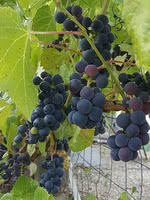Mon-Fri 9am - 5pm Mountain time
Valiant Grape vs Bilberry
Vaccinium myrtillus
Vitis x Valiant
CUSTOM GROW
NOT AVAILABLE THIS SEASON - MIGHT RETURN
Bilberry is a native perennial shrub valued for its small, blue-black berries that ripen in mid to late summer. The berries resemble blueberries but have a richer, more tart, and intense flavor. They have long been used for fresh eating, baking, and preserves, while also providing food for birds and mammals. In spring, its delicate pinkish flowers attract bees and other pollinators.
Growing low to the ground, Bilberry forms spreading colonies that create dense understory cover. This growth habit provides food and shelter for wildlife, and its foliage adds seasonal interest by turning red to purple in autumn. With its adaptability and ecological benefits, Bilberry is well-suited for naturalization, ecological restoration, and pollinator gardens.
Reported to be one of the hardiest of all grape varieties. This variety will produce bluish red clusters of grapes that are great for jellies and juice. Grapes have long been used to cover arbors and trellises.
This is a self-pollinating variety so only one plant is required to set fruit. Many like this variety for fresh eating as it is similar to concord grapes.
Grapes are a higher maintenance species requiring regular care and pruning. Unchecked and uncared for grapes can spread, be eaten by birds, and have lesser yields.
Applying a thick layer of mulch can help these vines overwinter better.
Note: We do not ship grape vines to BC due to regulatory restrictions from the Canadian Food Inspection Agency.
Bilberry Quick Facts
Valiant Grape Quick Facts
Toxicity: leaves may be unsafe in high doses

